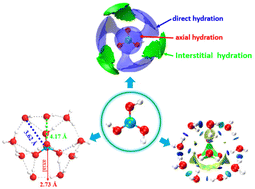Structural analysis of potassium borate solutions†
Abstract
In this work, H/D isotopic substitution neutron diffraction was combined with empirical potential structure refinement (EPSR) and DFT-based quantum calculations to study the interactions between B(OH)3 boric acid molecules, B(OH)4− metaborate ions, water molecules, and potassium cations in borate solutions. The results show that the solute ions and molecules have a marked effect on the second coordination shell of the water molecules, causing a greater deviation from a tetrahedral structure than is observed for pure water. Potassium ions and trans-B(OH)3 tend to form a monodentate contact ion pair (MCIP) with a K–B distance ∼3.8 Å, which remains constant upon changing the solution concentration. Potassium ions and cis-B(OH)3 form both a MCIP at K–B ∼3.8 Å and a bidentate contact ion pair (BCIP) at K–B ∼3.4 Å. As the solution concentration increases, there is a BCIP to MCIP transformation. Boric acid molecules can undergo hydration in one of three ways: direct hydration, interstitial hydration, and axial hydration. The energetic hydration preference is direct hydration → interstitial hydration → axial hydration. Nine water molecules are required when all water molecules directly interact with the –OH groups of B(OH)4−, and a tenth water molecule is located at an interstitial position. The hydrogen bonding between boric acid molecule/metaborate ion and water molecules is stronger than that between water molecules in the hydration layer.



 Please wait while we load your content...
Please wait while we load your content...